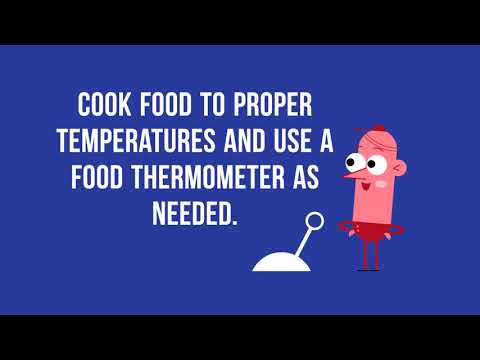In our last video and article, we gave you a bit of background info on bacteria—the good and the bad. We also talked about a pretty infamous potential foodborne illness-causing bacteria, E.coli. Remember, safe food handling tactics are key in minimizing your contact with bad bacteria and the threat of foodborne illness.
That Fiendish Fella, Salmonella
Now, let’s talk about another important bad bacteria—Salmonella. We have previously reported about food recalls due to Salmonella outbreaks that have caused many illnesses from various foods including cucumbers, fruits, pistachios, peanut butter, eggs and frozen chicken. While we have one of the safest and most reliable food systems in the world, recalls do occur from time to time and consumers need to stay up to date on avoiding any flagged foods.
Still, you may want to know just a little bit more about Salmonella than just a history lesson on recalls. If so, here are some tidbits and you can view our new video!
Like E.coli, there are different strains of Salmonella (actually over 2,500), not all can make you sick, but some can make you significantly ill—fewer than 100 strains cause the majority of illnesses in people. The Centers for Disease Control and Prevention, estimates that every year Salmonella causes one million foodborne illnesses in the United States, with 19,000 hospitalizations and 380 deaths.
Salmonella Food Safety Facts
We highlighted above that Salmonella can lurk in many different food sources (not just eggs and chicken), but here are a few more tidbits of info to help keep you safe:
- Salmonella thrives better under warm weather conditions. Thus, the spring and summer time provide prime weather for Salmonella growth, and food contamination incidences are likely to be higher this time of year. Additionally, unrefrigerated foods can provide Salmonella with good conditions for contamination and thriving. Thus, it is important to refrigerate perishables and leftovers in a timely manner.
- Salmonella infections can cause a many symptoms—vomiting, diarrhea and gastrointestinal pain. Typically symptoms occur within 6-48 hours after eating contaminated food.
- While most people can recover from Salmonella infections without antibiotics, children, older adults and others with weaker immune systems may need medical attention. Here’s some tips for addressing foodborne illness if you suspect you’ve eaten something contaminated.
Be Smarter Than Salmonella
While the U.S. has one of the safest food supply chains in the world, we still need to be proactive to avoid getting sick from potential bacteria contamination. The best way to avoid foodborne illness caused by bacteria like Salmonella is to practice safe food handling at all times. Chant “clean, cook, separate and chill” in your head and follow these guidelines along your way:
- Clean hands, utensils and sanitize food-contact surfaces often
- Cook food to proper temperatures and use a food thermometer
- Separate vegetables/fruits from raw meat and seafood to avoid cross-contamination
- Refrigerate or freeze (chill) perishables, ready-to-eat foods and leftovers within two hours of purchasing or preparation.
Stay tuned to our series to learn more about foodborne illness and the bad bacteria you should aim to avoid.

